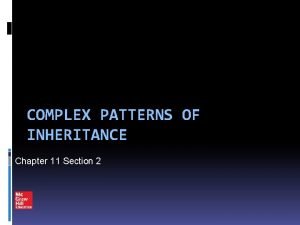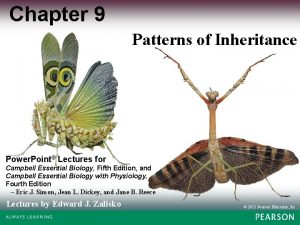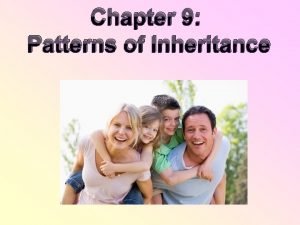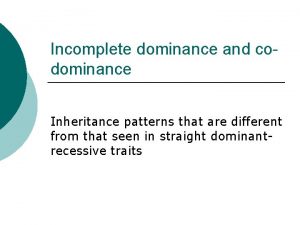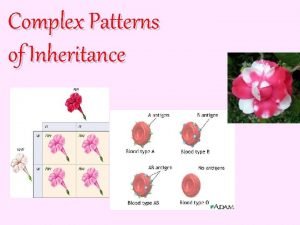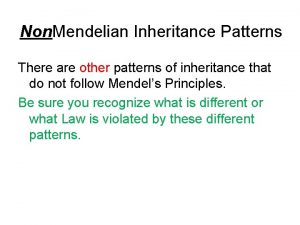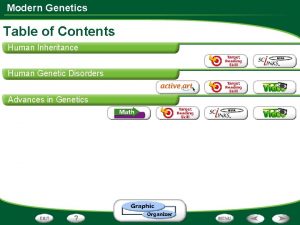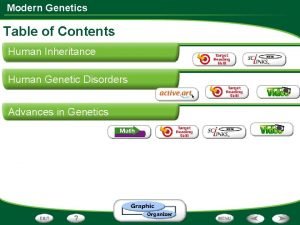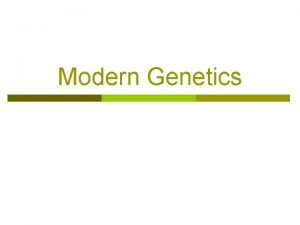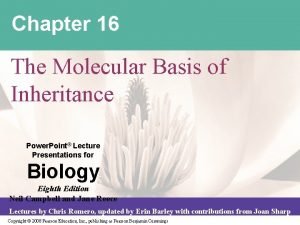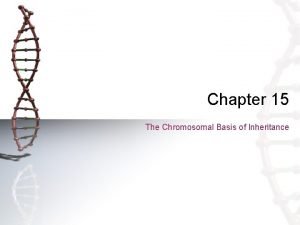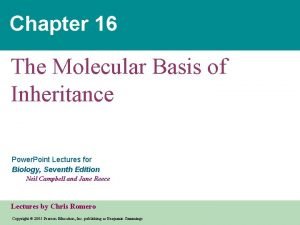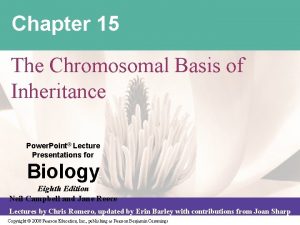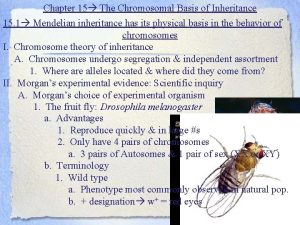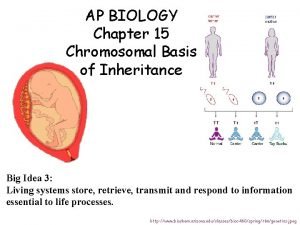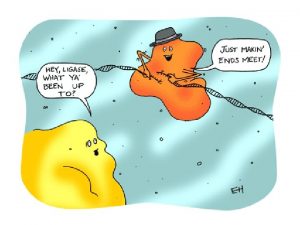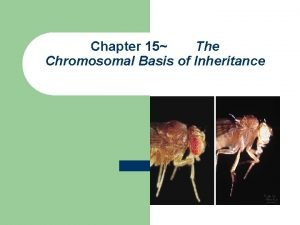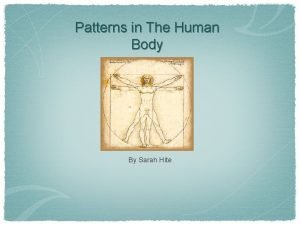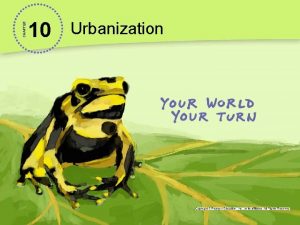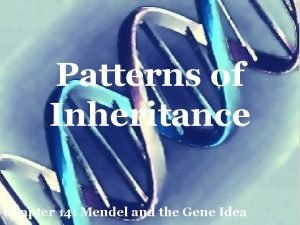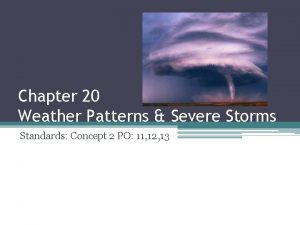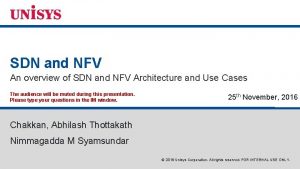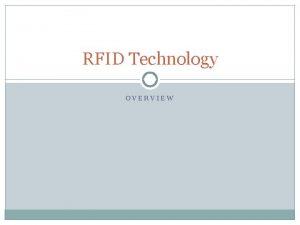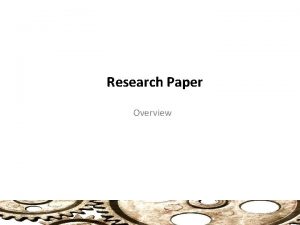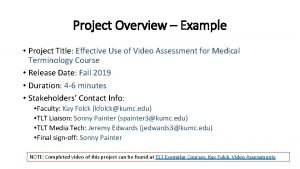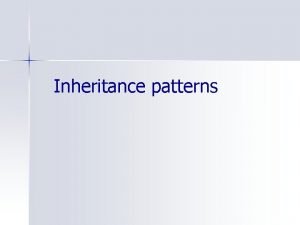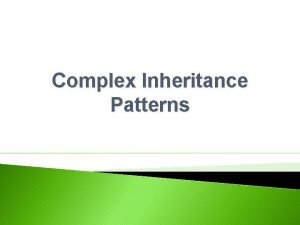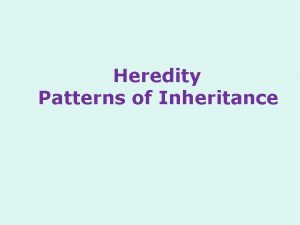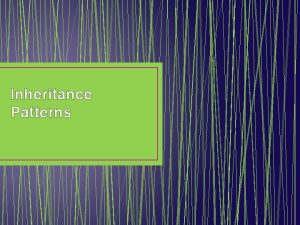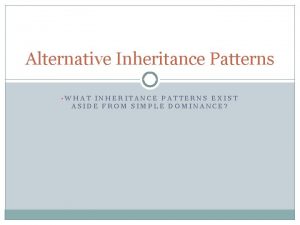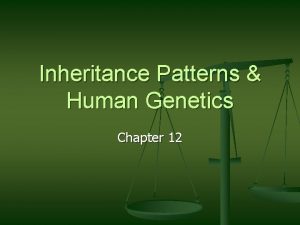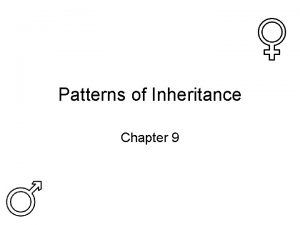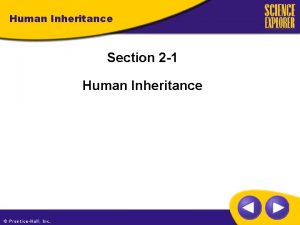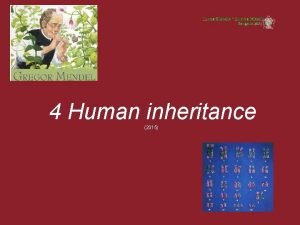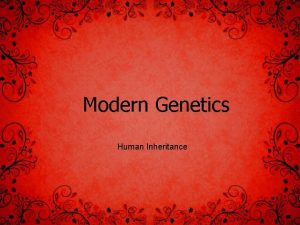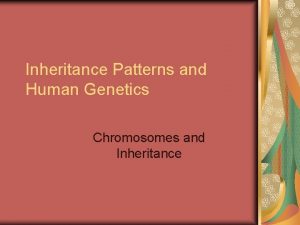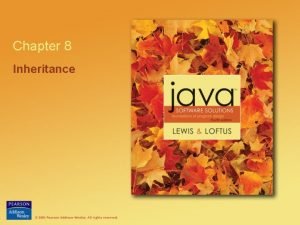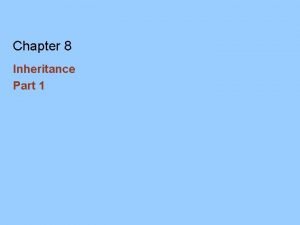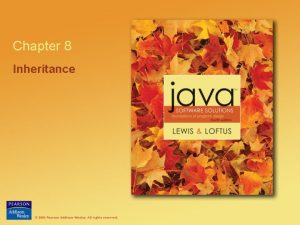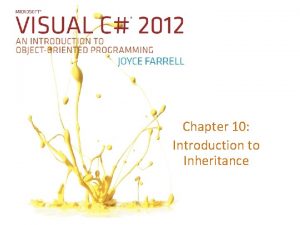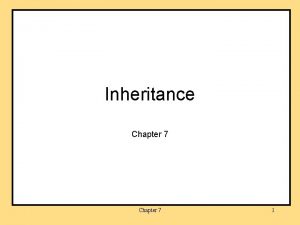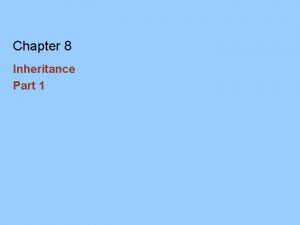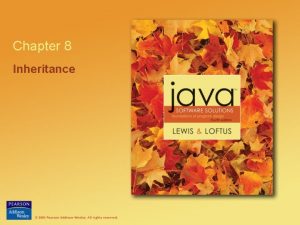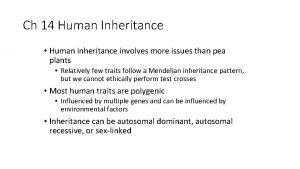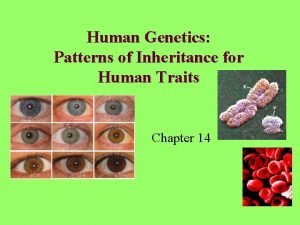Human Inheritance Chapter 9 Overview Human inheritance patterns


































































- Slides: 66

Human Inheritance Chapter 9

Overview Human inheritance patterns: – Autosomal – Sex-linked Sex determination systems

Human Chromosomes Humans: male & female, 2 n 23 pairs of homologous chromosomes in cells Each pair is structurally identical except sex chromosomes (Female XX, male XY) Autosomes are same in both sexes

Human X & Y chromosomes differ in appearance & genes Have small region that allows to act like homologues during meiosis Inheritance of sex chromosomes in certain combos determines gender

Karyotyping Individual’s metaphase chromosomes organized by length, shape, centromere location, etc. Can detect abnormalities in chromosome structure or altered chromosome # by comparing individual’s karyotype against species standard

Most traits come from autosomal dominant / recessive alleles inherited in simple Mendelian patterns Some of these alleles cause genetic disorders

Genetic Abnormality Rare / uncommon version of trait Not life-threatening e. g. polydactyly

Genetic Disorder Heritable condition Mild to severe medical repercussions Characterized by set of symptoms = syndrome

Autosomal Dominant Inheritance Dominant allele Trait usually appears each generation because allele is expressed in homozygous dominants & heterozygotes Remember: phenotypic ratio 3: 1 e. g. Huntington’s disease, lactose intolerance

Huntington’s Disease Degeneration of neurons in brain Affects 1/20, 000 – 1/1, 000 people Results in uncontrolled movements, emotional problems, loss of brain function Symptoms include mood swings, difficulty making decisions & retaining info No cure

If 1 parent is heterozygous & other is homozygous recessive, offspring has 50% chance of being heterozygous A a a a Aa Aa aa aa

Some dominant alleles that cause severe problems persist in populations because: • Expression of allele doesn’t affect reproduction • Affected individuals reproduce before symptoms are evident • Spontaneous mutations

Autosomal Recessive Inheritance Recessive allele Must be homozygous recessive to express trait If heterozygous for the trait = carrier e. g. cystic fibrosis, sickle cell anemia

Cystic Fibrosis Production of very thick, sticky mucus Affects lungs & digestive system (clogs lungs & hampers pancreas from breaking down & absorbing food) ~30, 000 people in US are affected Average lifespan = 35 -40 years

Sickle Cell Anemia Body produces abnormally-shaped RBCs = break down prematurely & cause anemia Affects 1/500 African-Americans If only 1 allele = sickle cell trait – 1/12 African-Americans have trait – Resistance to malaria

If both parents are carriers (heterozygous), offspring has 50% chance of being carrier (heterozygous) & 25% chance of being affected (homozygous recessive) A a A AA Aa aa

Sex Determination in Humans Every normal female egg has 1 X chromosome ½ of sperm cells have X, ½ have Y Sperm that fertilizes egg determines gender

The SRY Gene 1 of 255 Y chromosome genes Master gene for male sex determination When expressed in XY embryos, initiates testes formation Testes produce testosterone (controls expression of male 2 sexual traits)

XX embryo = no Y, no SRY, testosterone = ovaries form (make estrogens & other sex hormones that control expression of female 2 sexual traits)

The X Chromosome 1141 genes: Some associated with sexual traits distribution of body hair & fat e. g. Most of genes associated with non-sexual traits expressed in both males & females (because males get 1 X chromosome)

X-Linked Inheritance Thomas Hunt Morgan & Drosophila Determined that genes for non-sexual traits are located on X chromosome

X-Linked Inheritance Males show their only allele Males inherit only from mother Fathers pass their only allele to all daughters

X chromosome alleles result in phenotypes that follow simple Mendelian inheritance Many recessive alleles cause genetic disorders e. g. hemophilia A, red-green colour blindness

Hemophilia A Bleeding disorder (caused by lack of clotting factor) Occurs primarily in males (1/10, 000) Severity varies

Red-Green Colour Blindness Impairment or loss of function in light-sensitive cone cells in eyes Little or no perception of reds, greens, yellows Affects ~10% of males

Punnett Squares for X-Linked Crosses XXAA XA Y XA X AY Xa XA Xa X a. Y Set up in much the same way as regular Punnett Squares, but use X & Y to represent sex chromosomes with superscript letters to represent the alleles carried on those chromosomes

Unaffected female & affected male Female offspring: All carriers Male offspring: All normal

Carrier female & normal male Female offspring: 0. 5 carrier 0. 5 normal Male offspring: 0. 5 normal 0. 5 affected

Female carrier & affected male Female offspring: 0. 5 carrier 0. 5 unaffected Male offspring: 0. 5 normal 0. 5 affected

More males than females affected Heterozygous females have dominant allele on other X that masks recessive allele’s effects Males only have 1 X chromosome (no 2 nd X chromosome to counteract effects of recessive allele)

Females are the bridge between generations of affected males Unaffected male Affected male Unaffected female Carrier female

Pedigrees Genetic connections among individuals Info from several generations collected Can predict probability of trait being expressed as well as trace trait origins backwards

Basic procedure is to create a family tree & apply Mendelian genetics Can’t assume that an individual has a trait or is a carrier without evidence

A pedigree for a dominant trait I Common Symbols Used in Pedigrees II III A pedigree for a recessive trait I II ? ? III ? IV ? ? How to read pedigrees I, III = generations = male = female = parents = offspring or = shows trait or = does not show trait or = known carrier (heterozygote) for recessive trait ? or ? = cannot determine genotype from pedigree Notice you can use parents to determine children’s genotypes or children to determine parents’.

Looking at this pedigree, is the trait caused by a dominant or recessive allele? How do you know? Can you tell anything about the genotypes of these individuals?

Y-Linked Inheritance Genes can only be passed from father to son No effect from mother No effect on daughters e. g. hairy ear (pinna) syndrome

An Example In cats, coat colour is determined by an X-linked gene. The black allele causes black coat colour while the other allele, orange, causes orange colour, but in heterozygotes the cats are tortoiseshell (patches of black & orange). This is an example of what type of inheritance? What kind of offspring would you expect from a black female & an orange male?

Heritable Changes in Chromosome # Chance events occur before or after cell division that result in wrong chromosome # Consequences can be minor or lethal

Most changes in chromosome number occur because of non-disjunction = 1 pair of chromosomes do not separate during mitosis or meiosis

(a) Aneuploidy Normal # ± 1 chromosome Usually fatal Basis of most miscarriages Chances of non-disjunction with maternal age

e. g. Down Syndrome (Trisomy 21) Child inherits extra copy of chromosome 21 (2 n for all other chromosomes) 1/900 births

Distinct physical characteristics: Weak muscle tone, small mouth that can’t accommodate tongue, uniquely-shaped eyelids Varying degrees of mental retardation Often ↓ immune response, heart malformations

(b) Polyploidy Cells have ≥ 3 of each type of chromosome (e. g. 3 n, 4 n, etc. ) Many angiosperms, insects, fish, animals are actually polyploid Responsible for evolution via speciation

e. g. polyploidy in plants Fertilized diploid egg duplicates chromosomes but fails to divide = tetraploid (4 n) Produce diploid gametes that can fuse with other diploid gametes = 4 n offspring Can self-fertilize or interbreed with other 4 n individuals of same species

If breed with 2 n individual from original species, offspring is triploid (sterile because meiosis fails) 4 n & 2 n of original species can’t interbreed successfully = new species can form in 1 generation

Polyploidy is common in plants because they can reproduce asexually If a 4 n animal was produced, it would have to mate with a 2 n individual ↓ All 3 n offspring would be sterile ↓ = no speciation occurs

Changes in # of Sex Chromosomes Non-disjunction causes most of changes in # of X & Y chromosomes Relatively frequent: Often results in learning disabilities & speech problems

Female Sex Chromosome Abnormalities Turner Syndrome Trisomy X

(a) Turner Syndrome 1 X chromosome; no corresponding X or Y = XO Affects 1/2500 -1/10, 000 newborn females (75% because of non-disjunction from father) 98% of embryos spontaneously abort

Generally, XO females are 4’ 8” but wellproportioned ↓ sex hormone production & non-functional ovaries (2˚ sexual traits do not develop properly)

↑ risk of cardiovascular disease, kidney defects, hearing loss Display X-linked recessive disorders more frequently than XX women

(b) Trisomy X Women with 1 extra X chromosome =XXX 1/1000 live births

Some learning disabilities & taller than average, but otherwise no detectable defects Fertile adults (usually bear normal XX & XY children)

Male Sex Chromosome Abnormalities Klinefelter Syndrome XYY Syndrome

(a) Klinefelter Syndrome Inherit extra X chromosome from mother = XXY 1/500 -1/1000 males • 2/3 from non-disjunction at meiosis • Other 1/3 because Y chromosome fails to separate at mitosis (XY in some cells, XXY in others)

Syndrome develops during puberty: – Overweight, tall, small sex organs – Normal intelligence (some learning disabilities & short-term memory loss)

Feminizing effects because testosterone & estrogen ( sperm count, sparse hair, high voice, enlarged breasts) Testosterone injections can reverse female traits

(b) XYY Males 1/500 -1/1000 males Taller than average, ↑ ↑ testosterone levels, severe acne Mild mental impairment

Many XXX, XXY, XYY children not even diagnosed = unfairly categorized as underachievers

Why are changes in sex chromosome number tolerated? Remember X-chromosome inactivation? In females, one X chromosome is shut off Coils up chromosome so can’t be transcribed So … any extra X chromosomes get turned off

Sex Determination Systems XX / XY XX / XO ZZ /ZW # of chromosomes Hermaphrodites

XX / XY e. g. mammals, fruit flies Female = XX Male = XY Male produces 2 types of sperm (one has X, other has Y) Sex is determined by sperm cell at fertilization

XX / XO e. g. some insects Female = XX Male = XO Male produces 2 types of sperm (one type bears X, other has no sex chromosome) Sex is determined by sperm cell at fertilization

ZZ / ZW e. g. some fish, butterflies, birds Female = ZW Male = ZZ Female produces 2 types of egg (one type has Z, other has W) Sex is determined by egg cell at fertilization

Chromosome Number e. g. most ants & bees Have no sex chromosomes Sex determined by # of chromosomes: Female is 2 n & comes from fertilized egg Male is n & comes from unfertilized egg

Hermaphrodites e. g. many plants & invertebrates Have both male & female sex organs All individuals in a species have same complement of chromosomes Earthworm Lily Banana slug Possess a mechanism against self-fertilization so only function as a single sex at a time Prefer sexual reproduction but will self-fertilize Both stamen (male) & pistil (female) found on same flower
 Chapter 11 section 1 basic patterns of human inheritance
Chapter 11 section 1 basic patterns of human inheritance Chapter 11 section 1 basic patterns of human inheritance
Chapter 11 section 1 basic patterns of human inheritance Chapter 11 section 2 complex patterns of inheritance
Chapter 11 section 2 complex patterns of inheritance Chapter 9 patterns of inheritance
Chapter 9 patterns of inheritance Chapter 9 patterns of inheritance
Chapter 9 patterns of inheritance Chapter 11 complex inheritance and human heredity test
Chapter 11 complex inheritance and human heredity test Complete dominance pattern of inheritance
Complete dominance pattern of inheritance Complex patterns of inheritance
Complex patterns of inheritance Mendelian inheritance patterns
Mendelian inheritance patterns Dating serves several important functions that include
Dating serves several important functions that include Closed patterns and max-patterns
Closed patterns and max-patterns Intro to human resource management
Intro to human resource management Human inheritance modern genetics answer key
Human inheritance modern genetics answer key Genetics graphic organizer
Genetics graphic organizer Modern genetics human inheritance answer key
Modern genetics human inheritance answer key Emt chapter 24 trauma overview
Emt chapter 24 trauma overview Emt chapter 14 medical overview
Emt chapter 14 medical overview Chapter 9 lesson 2 photosynthesis an overview
Chapter 9 lesson 2 photosynthesis an overview Chapter 12 selling overview
Chapter 12 selling overview Chapter 2 an overview of the financial system
Chapter 2 an overview of the financial system Chapter 1 overview of verb tenses
Chapter 1 overview of verb tenses Overview of personal finance chapter 1
Overview of personal finance chapter 1 Tooth numbering system in usa
Tooth numbering system in usa Personal finance chapter 1 review answers
Personal finance chapter 1 review answers General features of animals
General features of animals Chapter 1 an overview of financial management
Chapter 1 an overview of financial management Elements and their properties section 1 metals
Elements and their properties section 1 metals Chapter 1 overview of financial statement analysis
Chapter 1 overview of financial statement analysis Chapter 16 the molecular basis of inheritance
Chapter 16 the molecular basis of inheritance Chapter 15 the chromosomal basis of inheritance
Chapter 15 the chromosomal basis of inheritance Chapter 16: the molecular basis of inheritance
Chapter 16: the molecular basis of inheritance 15/16
15/16 The chromosomal basis of inheritance chapter 15
The chromosomal basis of inheritance chapter 15 Chapter 15 the chromosomal basis of inheritance
Chapter 15 the chromosomal basis of inheritance Bioflix dna replication
Bioflix dna replication Chapter 15 the chromosomal basis of inheritance
Chapter 15 the chromosomal basis of inheritance Human needs and human development chapter 8
Human needs and human development chapter 8 Chapter 8 human needs and human development
Chapter 8 human needs and human development Patterns in human body
Patterns in human body Chapter 20 weather patterns and severe storms
Chapter 20 weather patterns and severe storms Chapter 24 patterns of climate answer key
Chapter 24 patterns of climate answer key Uncentered commercial (strip) development
Uncentered commercial (strip) development Dice and coin
Dice and coin Chapter 20 weather patterns and severe storms
Chapter 20 weather patterns and severe storms Www description
Www description Maximo overview
Maximo overview Uml overview
Uml overview Uml overview
Uml overview Vertical retail
Vertical retail Figure 12-1 provides an overview of the lymphatic vessels
Figure 12-1 provides an overview of the lymphatic vessels Systemic artery
Systemic artery Texas recapture districts
Texas recapture districts Walmart company overview
Walmart company overview Stylistic overview of architecture
Stylistic overview of architecture Sa-sd
Sa-sd Spring framework overview
Spring framework overview Nagios tactical overview
Nagios tactical overview Market overview managed file transfer solutions
Market overview managed file transfer solutions Nfv vs sdn
Nfv vs sdn Sbic program
Sbic program Sap mm overview
Sap mm overview Ariba overview
Ariba overview Safe overview
Safe overview Rfid technology overview
Rfid technology overview Sots meaning in research
Sots meaning in research Perbedaan replikasi virus dna dan rna
Perbedaan replikasi virus dna dan rna Project heading example
Project heading example


